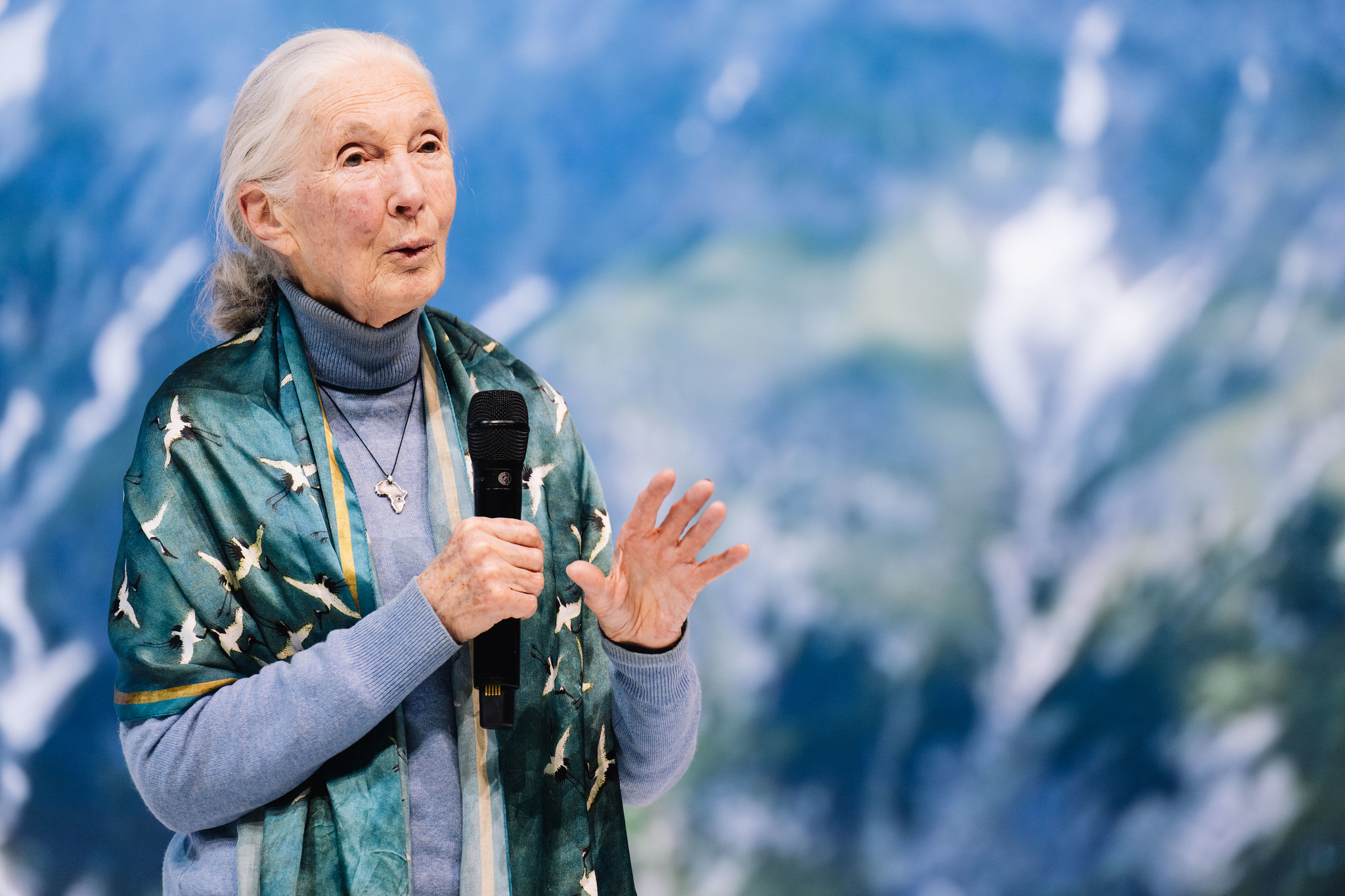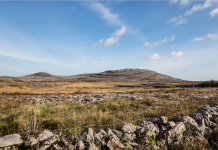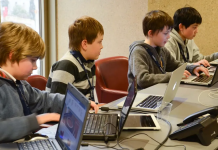Written by: Dr. Jane Goodall, DBE
I travel around the world 300 days a year, and everywhere, I meet young people who have lost hope. And we know that suicide rates are going up. If all our young people lose hope, then we are doomed. Because if you lose hope, you become apathetic. You give up and you do nothing. The future depends on all of us getting together now and doing something to try and heal the harm we have inflicted on this planet. How long can the earth survive if we continue as we are now?
I’ve spent many years in the rainforest, understanding the interconnection of all living things. I learned about chimpanzee behaviour and about this amazing ecosystem of the forest, where every plant and animal has a role to play. I see it as like a beautiful tapestry of interconnected life forms. As humans move in with their cattle, development and deforestation, a strand from the tapestry is gradually pulled away, one after the other, as a particular animal or plant disappears from that ecosystem. And if enough threads are pulled, the tapestry will hang in tatters and the ecosystem will collapse.
We must realize that we humans are not separate from the natural world. So many people live in cities and are unaware that we depend on the natural world for everything: food, water and clothing. We rely on healthy ecosystems. But as we continue our selfish development of this materialistic lifestyle, we destroy these ecosystems. We need a new mindset.
I spend a lot of time talking to different people around the world – to children, CEOs, government officials and anybody who will listen. I have realized that if you want to change somebody, there’s no use arguing with them. It’s no good pointing fingers and saying, “What you’re doing is bad for future generations.” They’re not going to listen. They don’t want to listen.
So, how do you change people? You have to change people by reaching their hearts. I think that when people change, it’s got to be their decision to change from within. So, when I’m talking to these decision-makers who have such sway over us, I try to find a way to reach the heart. The way that I see the most effective is to tell stories.
Sustainable narratives
So, I’ll tell you a story: I was talking to a group of CEOs in Singapore. One of them was the head of a big multi-multinational corporation. He said that for the last eight years, I have been fighting to get my company to be sustainable and ethical in the country where we source our supplies, in our offices around the world and in how we treat our customers. He said there were three reasons why I wanted to make my company more ethical.
First, he said, because I saw the writing on the wall, we were using natural resources faster than nature could replenish them in many places. Second was consumer pressure – people are beginning to understand and become more aware. They’re starting to ask questions like: Why is this product cheap? Is it because of unfair wages paid in other countries? Is it because of some kind of slave labour? Was the making of it damaging to the environment? Was it cruel to animals? But here we are; we don’t seem to understand what we are doing to harm the planet.
But the third reason that triggered everything for me was when my 10-year-old little girl came back from school one day and said, “Daddy, they’re telling me that what you’re doing is harming the planet. That’s not true. Is it Daddy? Because isn’t it my planet”? That reached the heart.
The world is in a mess politically, socially and, of course, environmentally. I’ve been asked so many times during this week in Davos, “Well, don’t you think that the terrible wars in Gaza and the Ukraine are detracting attention away from the threat of climate change and loss of biodiversity?” And we all must, if we have any human instincts, feel desperation when we think of children in Gaza being operated on and having limbs amputated without anaesthetic because there’s no anaesthetic left. What are we doing about people who are facing famine? What can we do about it?
I don’t know. But although this is terrible and the Ukrainians moving into deep winter should make all our hearts bleed. That does not mean that we shouldn’t also focus our attention on climate change because that affects the future of our children, our grandchildren and theirs.
Navigating towards hope and action
I see humanity as at the mouth of a very long, very dark tunnel. And right at the end of that tunnel, there’s a little star that’s hope. And it’s no good sitting at the mouth of the tunnel folding our arms and hoping that the star will come. No, we have to roll up our sleeves. We have to climb over, crawl under and work our way around all the obstacles that stand between us and the star: climate change; biodiversity loss; killing of the soil with agricultural poisons, pesticides and herbicides; harming the ocean with our artificial fertilizers; and poverty. Poverty drives some people to destroy the environment simply to eke out a living by making charcoal or by clearing the forest to make more land to grow food for their growing families.
The good news is that there are groups of people tackling every single one of the problems we face today. Every single one.
The sad thing is that so often, people work in silos. They are concentrating only on solving their problem. For instance, imagine that we are a group fighting the closure of a coal mine because of all the carbon dioxide (CO2) emissions. We’ve closed it but haven’t been thinking holistically; we haven’t been thinking of all the people who will lose jobs and how we are plunging them into deep poverty. But if we start thinking holistically from the beginning, we can find ways of helping all these people who lose their jobs to make a living so that we get a win-win-win situation.
We need to collaborate and take action now. Many of these big conferences are fantastic – they create networking and people meet and inspire each other, leading to much good. But as you all know, there are a lot of intentions and commitments to reducing emissions but very seldom are those commitments honoured. The time for talk has passed. What we need today is action.
My greatest hope lies in young people today. In 1991, I was already meeting young people worldwide who had lost hope, were angry, depressed or just apathetic. And they said, well, you’ve compromised our future and there’s nothing we can do. I said that’s not true.
We do have a window of time; if we get together, we can start to make a change. So that began the Jane Goodall Institute’s Roots & Shoots programme.
Every group of Roots & Shoots chooses three projects to help people, animals, and the environment because they are all interrelated. And what began with 12 high school students in Tanzania is now in 70 countries around the world. And these young people are planting trees, collecting plastic and raising money for projects that they’re passionate about. They’re changing the world as I speak.
Hope through nature, innovation and human spirit
There are so many reasons for hope. Young people are my main reason for hope. My second reason is the resilience of nature. We destroy an entire ecosystem. Give it time and nature will come back. Animals on the brink of extinction can be given another chance.
My next reason for hope, the biggest difference between us and other animals, is this explosive development of our intellect. Yes, other animals are far more intelligent and sentient than used to be believed. We’ve designed a rocket that went up to planet Mars with a robot that took photos. And so, our hope of finding a planet where life could continue, a kind of life we know, was doomed.
Fortunately, today, science is coming out with innovative solutions like capturing carbon from the atmosphere and renewable energy. This is a big step forward. I wish more people were talking about this type of technological solution, which is one way we can live in greater harmony with nature.
But nature protects itself through forests, oceans, kelp forests and wetlands. These ecosystems are nature’s solutions to climate change. They’re cheaper than some of these technological solutions. And that’s really the message I’ve been trying to give in Davos: by protecting the forest and Mother Nature, Mother Nature will help us escape the mess we’ve made.
And my last reason for hope: the indomitable human spirit – the people who tackle what seems impossible and won’t give in so often succeed. So, when our Roots & Shoots groups get to the end of a session we bring groups face to face from different parts of a city, country or even the world. They stood up and said, “Together we can.” Meaning, together we can save the world. And I said, “Yes, we can.”
We know what we ought to do. We understand all the different ways that we can combat and slow down climate change. But do we have the will? Do governments have the will? Do the people have the will to make those little concessions? If you believe that we have a window of time, could you join me in saying, “Together we can, together we will, together we must save the world?”
Header Image Credit: World Economic Forum/Flickr (CC BY-NC-SA 2.0)
Republished with permission from World Economic Forum







